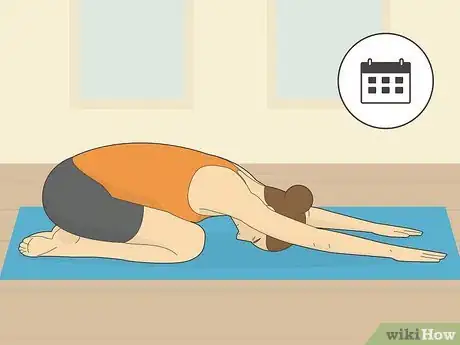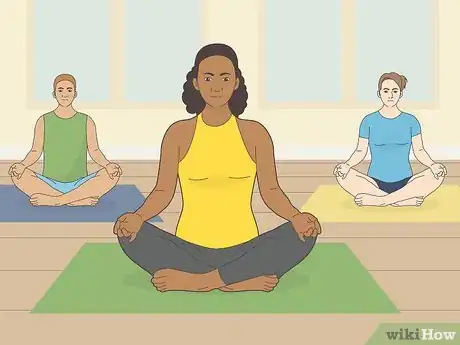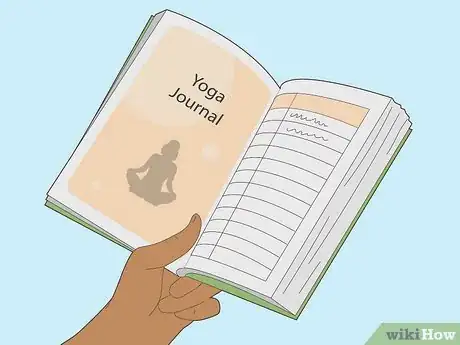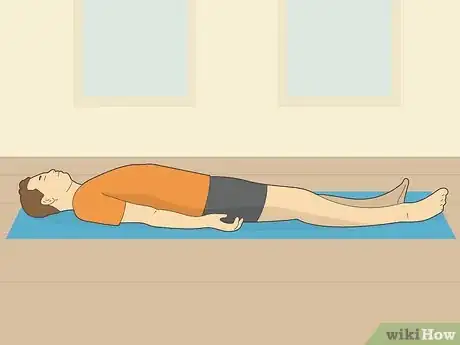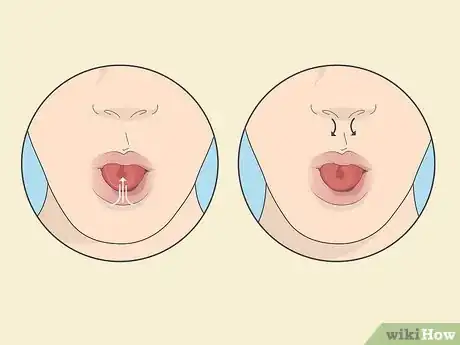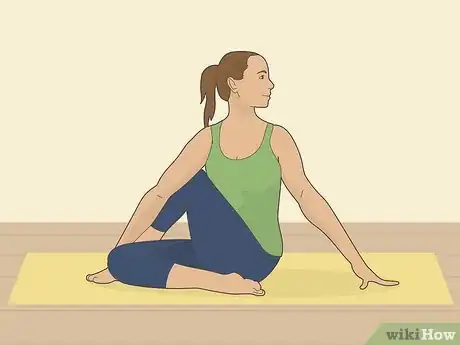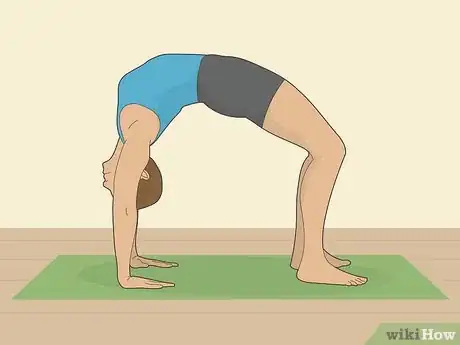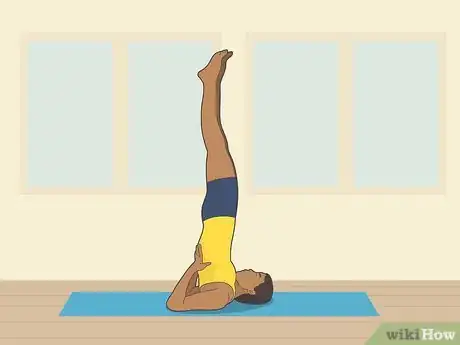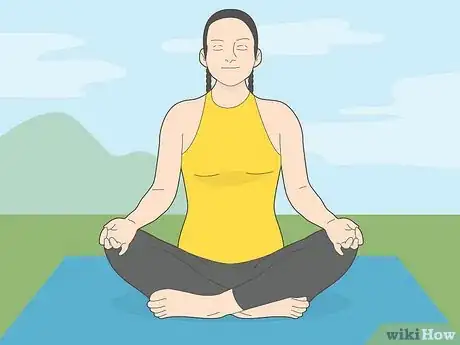This article was co-authored by Trudi Griffin, LPC, MS. Trudi Griffin is a Licensed Professional Counselor in Wisconsin specializing in Addictions and Mental Health. She provides therapy to people who struggle with addictions, mental health, and trauma in community health settings and private practice. She received her MS in Clinical Mental Health Counseling from Marquette University in 2011.
There are 22 references cited in this article, which can be found at the bottom of the page.
wikiHow marks an article as reader-approved once it receives enough positive feedback. In this case, 100% of readers who voted found the article helpful, earning it our reader-approved status.
This article has been viewed 142,897 times.
Many of us feel anger, irritability and frustration throughout the course of our daily lives. Exercise can be a great daily treatment to release those feelings. If you find yourself getting angry often, yoga may be able to help! One 2021 study conducted by the Academy of Family Physicians of India suggests that yoga can improve your ability to regulate and process emotions, which is key when it comes to anger management.[1] In other words, yoga can provide you with the skills you need to calm down in the moment, while improving your ability to manage anger in the long-term!
Steps
Addressing Anger Through Yoga Practice
-
1Develop a regular practice. Practicing yoga regularly will go a long way toward helping you manage your anger long term. If you have a particularly hostile or irritable personality type, practicing regularly will help reinforce the short term benefits from merely practicing a pose once or twice or going to a class once. You need not go to a class to practice basic yoga, but you might want to go to a class in order to learn more advanced poses.[2] [3]
-
2Join a class if you are beginner. Sometimes it can be helpful for beginners to practice yogas with other to get the hang of the types of routines they can try. It is also helpful to assuaging anger if you are feeling the support of the group when practicing yoga. However, if you have a competitive personality, practicing in a group might undermine your efforts.[6]Advertisement
-
3Watch online videos to develop your practice. For beginners and more advanced students, watching videos can help you develop a practice as they often include routines that last anywhere from 5 minutes to an hour or more. There are plenty of yogis out there with different styles such as Adriene of the YouTube channel "Yoga with Adriene" which is calm but cheerful, or more exercise focused like Brian Jones of the YouTube channel "Muscle and Mat".[7]
-
4Practice focusing on your breath. Focus on the breath is a central part of yoga practice. It is essential to focus on your breath to get the most out of the yoga poses you are trying. The deeper the breath the better. Take your time, and continue the exercise until you feel calmer.[10]
-
5Keep a yoga journal or spiritual diary. Keeping a yoga journal allows you to see over time how yoga is affecting your overall anger. It can also be a place to document the pleasures and frustrations of yoga after your regular practice.[11] In addition, writing can reduce the intensity of your anger.[12]
Trying Specific Poses for Anger Management
-
1Do the corpse pose (Savasana). With the corpse pose, you lie on your back with your palms up, arms at your side. Then you relax each part of your body in turn. While doing all of this, focus on your breathing. Breathe deeply into your belly. This is a pose that is best done with your eyes closed or relaxed.[13]
-
2Release anger with Sheetali Pranayama (cooling breath). The cooling breath is an excellent way to address anger.[14] You simply roll your tongue (curling in the edges) or purse your lips if you can't roll your tongue, and inhale slowly through your mouth so that the breath comes through your rolled up tongue. Then, close your mouth and exhale through your nose. This practice is thought to reduce anger and improve focus.[15]
-
3Try a half twist pose (Ardha Matsyendrasana). This pose was thought to wring out anger by early Buddhist monks. It massages the internal organs and stretches your spine.[16] You can accomplish pose by sitting with both legs ahead of you then bending one knee up while bending the other on the ground underneath the other leg. You then twist your spine toward the side where the knee is up and use the knee as a rest for your arm as you stretch further into the pose. Don't push yourself. If you feel pain, relax a bit.[17]
-
4Do a back bend or the Upward Bow pose (Urdhva Dhanurasana). This pose has been shown to improve confidence in people with hostile or irritable personality types, as well as reduce anger. While there are several ways to achieve a backbend in yoga, the Upward Bow pose is the most common, as it is what people usually think of when they think of back bends. This is a somewhat advanced pose, and you may do well to learn it with a qualified yoga instructor.[18] [19]
- Use caution in this pose, as this is a pose that can put pressure on the neck which can be hazardous for many individuals.
- Use modifications on this pose if this is difficult! The same benefit can be gotten from Plow Pose with supports as directed by a qualified instructor as without.
-
5
Breathing Deeply to Release Anger
-
1Breathe deeply. Breathing has long been a central part of yoga.
- Focusing on your breath before, during, and after yoga sessions will greatly benefit anger management. Breathing deeply is also good for other negative emotions, as it physiologically calms you down. Make sure to breathe deep into your diaphragm. You should be able to feel/see your belly rise and fall while doing this.[22] [23]
- Breathe out slowly. The time taken to breathe out is approximately four times the time taken to breathe in.
-
2Relax your body. Take time to relax your muscles from head to toe, one by one. This will help release tension in parts of your body you may not have realized were even there. Don't rush. Take your time.[24]
- If you feel like you are having trouble slowing down, then you can also do a guided body scan meditation that will take you through all the parts of your body.[25]
-
3Feel your anger. This is not about thinking about the anger. Rather you just need to stay with the emotion. Feel all of it. Notice where you feel it in your body. Notice the intensity. Don't judge the feelings. If thoughts do arise, acknowledge them and then return to noticing your emotions.[26]
-
4
How Do You Reduce Distractions During Yoga?
Warnings
- Yoga for anger management can be used alone, but will likely work best with therapy and/or other treatments.⧼thumbs_response⧽
- For the more difficult poses, it's best to work under the guidance of a yoga teacher.⧼thumbs_response⧽
References
- ↑ https://www.ncbi.nlm.nih.gov/pmc/articles/PMC7567196/
- ↑ https://yogainternational.com/article/view/the-beginners-guide-to-home-yoga-practice
- ↑ http://www.artofliving.org/meditation/meditation-for-you/tips-for-reducing-anger
- ↑ http://www.mindbodygreen.com/0-4455/8-Most-Common-Questions-from-Yoga-Beginners.html
- ↑ https://www.ekhartyoga.com/blog/yoga-faq-for-beginners
- ↑ http://anmolmehta.com/blog/2007/08/28/top-5-benefits-of-group-yoga-practice/
- ↑ http://nymag.com/thecut/2016/01/best-free-yoga-classes-online.html
- ↑ https://www.youtube.com/watch?v=ie5yjNGLxfQ
- ↑ https://www.youtube.com/watch?v=eLyCd8i_gGM
- ↑ http://www.yogajournal.com/article/practice-section/healing-breath/
- ↑ http://www.yogabasics.com/connect/yoga-blog/benefits-of-keeping-a-yoga-journal/
- ↑ http://psychcentral.com/lib/the-health-benefits-of-journaling/
- ↑ http://www.livestrong.com/article/338794-yoga-poses-for-anger/
- ↑ http://www.livestrong.com/article/338794-yoga-poses-for-anger/
- ↑ https://www.verywell.com/how-to-do-cooling-breath-shitali-pranayama-3566761
- ↑ http://spiritualityhealth.com/articles/7-ways-tame-anger-ayurveda
- ↑ http://www.artofliving.org/us-en/yoga/yoga-poses/sitting-half-spinal-twist-ardha-matsyendrasana
- ↑ http://www.yogajournal.com/pose/upward-bow-or-wheel-pose/
- ↑ http://marc.ucla.edu/workfiles/pdfs/david%20shapiro%20karen%20cline.pdf
- ↑ http://www.artofliving.org/us-en/yoga/yoga-poses/shoulder-stand-sarvangasana
- ↑ http://www.livestrong.com/article/338794-yoga-poses-for-anger/
- ↑ http://www.yogajournal.com/article/yoga-101/unmasking-anger/
- ↑ http://www.health.harvard.edu/mind-and-mood/yoga-for-anxiety-and-depression
- ↑ http://www.yogajournal.com/article/yoga-101/unmasking-anger/
- ↑ https://www.youtube.com/watch?v=_vN3wkatdts
- ↑ http://www.yogajournal.com/article/yoga-101/unmasking-anger/
- ↑ http://www.yogajournal.com/article/yoga-101/unmasking-anger/
